Villa Careggi
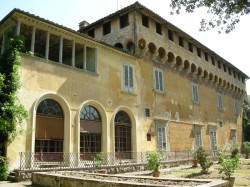 It is believed that the Careggi villa in Florence was the first of many family-owned villas in Florence area and throughout Tuscany. In the 15th century it was known as the seat of the Platonic Academy, which was instituted by Gemistus Pletho and richly funded by Cosimo the Old. The Academy has never been an official educational institution, only the discussion group of the most famous philosophers of the city at that time. This is the villa where Cosimo il Vecchio died in 1464. Michelozzo, the architect of the villa, endowed the building with the features of fortress by installing defensive elements. There is also a garden. You can visit the villa making an appointment in advance.
It is believed that the Careggi villa in Florence was the first of many family-owned villas in Florence area and throughout Tuscany. In the 15th century it was known as the seat of the Platonic Academy, which was instituted by Gemistus Pletho and richly funded by Cosimo the Old. The Academy has never been an official educational institution, only the discussion group of the most famous philosophers of the city at that time. This is the villa where Cosimo il Vecchio died in 1464. Michelozzo, the architect of the villa, endowed the building with the features of fortress by installing defensive elements. There is also a garden. You can visit the villa making an appointment in advance.
Villa Medici in Fiesole
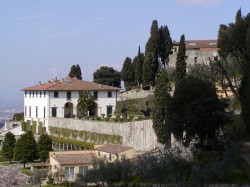 The Medici villa in the hills of Fiesole is one of the most beautiful, the oldest and also one of the best preserved, but at the same time is also one of the least well known family villas. Built during in the middle of the 14th century, it was the first Renaissance true countryside villa, rather than just one of many typical country houses. This villa has become a source of inspiration for many architects and noble families. This was the villa without fortifications, elegant, with lots of terraces and a garden gently sloping down. The villa is open only to groups and visits have to be arranged in advance.
The Medici villa in the hills of Fiesole is one of the most beautiful, the oldest and also one of the best preserved, but at the same time is also one of the least well known family villas. Built during in the middle of the 14th century, it was the first Renaissance true countryside villa, rather than just one of many typical country houses. This villa has become a source of inspiration for many architects and noble families. This was the villa without fortifications, elegant, with lots of terraces and a garden gently sloping down. The villa is open only to groups and visits have to be arranged in advance.
Villa di Poggio Imperiale
Villa of the imperial hill in Florence – that is how the name of this palace sounds in English – the property of the Medici family in neoclassicism style. Later it belonged to Napoelon’s sister and eventually it was converted to a prestigious girls’ school. It has often been at the centre of major events, important to entire Italy, therefore it has been rebuilt many times – stucco mouldings, decorations, extra rooms, neoclassical facades and plenty of other changes were made during the last, but the biggest renovation in the 18th century. Only the main facade remained almost unaltered. You can visit this villa only if arranged in advance.
Villa Medicea di Poggio a Caiano
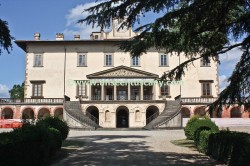 La Villa Medicea di Poggio a Caiano, also known as the ‘Amber’ – is one of the most famous properties of the Medici family, which houses a museum at the moment. The construction of this villa was financed by Lorenzo il Magnifico. It is one of the examples of Renaissance architecture with obviously seen ideas of Vitruvius, the elements of classic temples and Tuscan countryside buildings as well as innovative ideas. The villa stands on a high base, which offers spectacular views of the surrounding park and natural landscape. Inside, there is the Museum of Still Life (Natura Morta), displaying paintings (over 200 pcs.) collected by the Medici. It is possible to visit both visit the park and the villa.
La Villa Medicea di Poggio a Caiano, also known as the ‘Amber’ – is one of the most famous properties of the Medici family, which houses a museum at the moment. The construction of this villa was financed by Lorenzo il Magnifico. It is one of the examples of Renaissance architecture with obviously seen ideas of Vitruvius, the elements of classic temples and Tuscan countryside buildings as well as innovative ideas. The villa stands on a high base, which offers spectacular views of the surrounding park and natural landscape. Inside, there is the Museum of Still Life (Natura Morta), displaying paintings (over 200 pcs.) collected by the Medici. It is possible to visit both visit the park and the villa.
Villa Medicea di Castello
There is a villa located near Florence, built in the 15th century by order of the Medici family. It was the place where the future ruler of Florence and the first Grand Duke of Tuscany, Cosimo I de ‘Medici, spent his childhood. Being already an adult, he expanded his favourite villa and commissioned to create here a garden with lots of trails and running water, together with the Animal Grotto that survived till nowadays. During the period of the Lorenzo il Magnifico, this villa housed the famous Botticelli’s painting ‘The Birth of Venus’. Tourists can visit the park.
Villa La Petraia
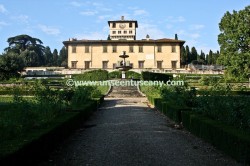 Villa La Petraia is considered one of the most beautiful of all Medici Villas. The fortified mansion is situated on a high hill with a magnificent view of Florence. In front of the villa there is a green geometric shaped garden, and behind the palace – a huge English park, divided into three terraces. Perhaps the most impressive parts of the villa are the courtyard decorated with frescoes and a room with the famous bronze statue of Venus/Florence by Giambologna. You can visit both the park and the villa.
Villa La Petraia is considered one of the most beautiful of all Medici Villas. The fortified mansion is situated on a high hill with a magnificent view of Florence. In front of the villa there is a green geometric shaped garden, and behind the palace – a huge English park, divided into three terraces. Perhaps the most impressive parts of the villa are the courtyard decorated with frescoes and a room with the famous bronze statue of Venus/Florence by Giambologna. You can visit both the park and the villa.
Villa Demidoff
Villa Demidoff is a new name of Villa Medicea di Pratolino. In 1822 this villa was demolished, and the territory was purchased by the Russian Demidoff family. Currently, you can visit a huge English-style park and see the statue of the Giant, located in it.
Villa Medicea di Cafaggiolo
Villa Medicea di Cafaggiolo is situated a several dozen kilometres outside of Florence, near the Sieve River.It belonged to the Medici family since the 14th century, and its first owner was Averardo de ‘Medici. His son Giovanni di Bici de’ Medici is considered to be the initiator of the Medici dynasty. The current villa was built in the middle of the 15th century according to Michelozzo’s plan. Tourists are allowed to visit this villa.
Villa del Medicea Trebbio
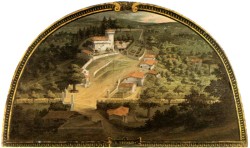 Villa del Trebbio was one of the first Medici villas outside Florence and its suburbs.The villa is located in a strategically important place, on a hill near the crossroad of ancient trade routes. This palace belonged to the initiator of the Medici family and the first family banker Giovanni di Bicci. Family architect Michelozzo converted the first villa into the fortified castle with a garden, surrounded by a high fence.Since 2008 the villa belongs to a private person and here is the wine produced. The villa can be visited during the tastings.
Villa del Trebbio was one of the first Medici villas outside Florence and its suburbs.The villa is located in a strategically important place, on a hill near the crossroad of ancient trade routes. This palace belonged to the initiator of the Medici family and the first family banker Giovanni di Bicci. Family architect Michelozzo converted the first villa into the fortified castle with a garden, surrounded by a high fence.Since 2008 the villa belongs to a private person and here is the wine produced. The villa can be visited during the tastings.
Villa Medicea di Cerreto Guidi
Villa Medicea di Cerreto Guidi is one of the few Medici family villas that are constantly open to the public. It houses the regional and hunting museum. The villa was built in the middle of the 16th century on the foundations of former building by the request of Cosimo I de’Medici’s. Cosimo loved to use this villa for ‘his own needs’ (for hunting and a gateway from family). Isabella de ‘Medici, the daughter of Cosimo I and his wife Eleanor, was murdered here. The killer was her husband who wanted to punish Isabella for adultery. You can visit both the villa and the garden.
Villa Medicea di Artimino
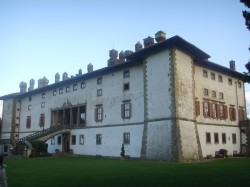 Villa Medicea di Artimino, also known as the ‘Villa of the One Hundred Chimneys’, is located in the small town of Artimino. At the moment it hosts an archaeological museum and a space for conferences. The palace was built by Ferdinando I de’ Medici’s request according to the plan of architect Buontalenti. The villa stands on a hill with a magnificent view of the surrounding countryside. It was one of the last villas of the Medici family, built in just four years and embodying all of Medici villas style and beauty. Between 1599 and 1602, Giusto Utens painted the famous 17 lunettes, where he captured all of the Medici family villas. The lunettes astonish with the abundance of details and precision and illustrate the villas from a bird’s-eye perspective. It is necessary to agree the time of visit in advance.
Villa Medicea di Artimino, also known as the ‘Villa of the One Hundred Chimneys’, is located in the small town of Artimino. At the moment it hosts an archaeological museum and a space for conferences. The palace was built by Ferdinando I de’ Medici’s request according to the plan of architect Buontalenti. The villa stands on a hill with a magnificent view of the surrounding countryside. It was one of the last villas of the Medici family, built in just four years and embodying all of Medici villas style and beauty. Between 1599 and 1602, Giusto Utens painted the famous 17 lunettes, where he captured all of the Medici family villas. The lunettes astonish with the abundance of details and precision and illustrate the villas from a bird’s-eye perspective. It is necessary to agree the time of visit in advance.

